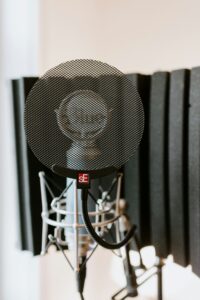For whatever reason, at a certain point in my life someone told me that I could get a five-foot didgeridoo on sale for fifteen bucks and I thought it was a great deal. If you’re unfamiliar with this aboriginal wind instrument used to produce low droning sounds, it’s basically a hollow wooden tube that flutes out at one end that you blow into with your lips together. And believe it or not, it saved my voice.
Now I’d learned the basic vocal warm-ups singing in my high-school choir: humming, lip trills, scales, tongue-twisters, and it felt like lifting one-pound weights at the gym – was it all really necessary? When am I ever going to hurt my throat?
As fate would have it, I’d go on to learn a lot more about the physics of sound and vocal anatomy. Your throat is basically a tube, and even though you call them vocal ‘cords’ they’re more like sets of lips that expand and constrict to let air pass through at different speeds. Think about letting air out of a balloon; when you pinch it tight and air pushes its way out, you get a high-pitched squeak. And when you just let the air flop out you get equally-silly low notes.
Well anyway, I bought the didgeridoo, and the more I thought about it, the didgeridoo is just like a big throat, where lips act like vocal cords. It tickles at first, because of all the vibration going into your face, but that’s exactly why singers hum. It loosens vocal pathway and clears out the spaces where your voice resonates.
But the key to playing a didgeridoo is breath control—you can’t get a good drone going if you run out of breath. And so a big part of learning to play is exercising your breathing so you can exhale consistently for up to a minute at a time. That means learning to breathe with your whole body, storing air in your lungs, pushing it out with your diaphragm and strategically rationing it so you can keep it flowing. In fact, consistent airflow is exactly how singers are able to hold a note.
I was curious, so one day I asked myself, “what would happen if I hummed and played the didgeridoo at the same time?” Expecting maybe a faint harmony, I was blown away when it felt like the sound of the didgeridoo was traveling backward

into my lungs. Like feeling the bass at a concert, this impossibly low sound was massaging my vocal pathway.
This happened because the way sound fills up a space or ‘resonates’ depends on how much room you give the sound to travel. By opening my vocal folds to hum, I was giving the didgeridoo’s sound more room to travel. At the end of the day, what this amounts to is a lot of natural vibrations traveling in a bunch of different directions at the same time as a meditative breathing exercise.
The day finally came when I went too far in a voice-over session talking like a pterodactyl. I hurt my throat bad enough to lose a full upper octave of my voice. Notes just weren’t coming out. Frantically searching for cures and exercises I was downing throat coat tea with way too much honey and scaring myself with throat health articles that didn’t really apply to my situation. But I did find some hope in articles and videos that said I could exercise my voice back to health.
What they recommended was vocal rest, proper breathing, humming, lip trills, scales, and breath strengthening with a constant 40-second hiss (try it.) For a while I did these and the progress was slow. Then looking over to the didgeridoo in the corner, I realized I could be doing all of those things at the exact same time, while also picking up those good vibrations.
My voice did come back, and now with proper vocal technique, regular exercise, and the occasional toot of the didge, I’m up to whatever bizarre challenges voice acting throws at me.
Like this? Read yesterday’s article about VO, health, and wellness here!





